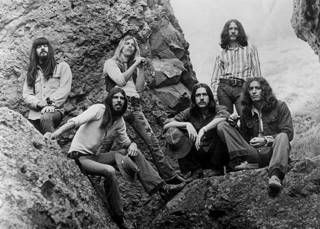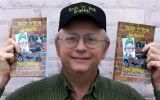
Black Oak Arkansas
By STEVE SEYMOUR
The crowded AM radio spectrum offered plenty of choices to the curious listener in the era before FM came into dominance.
Among the channels I discovered while twisting the dial late at night was KAAY, a 50,000 watt giant broadcasting from Little Rock, Ark.
There, I heard the fascinating "Beaker Street," a music program which abandoned the Top 40 concept, instead concentrating on album cuts which escaped airplay elsewhere.
Beginning in 1966, Beaker Street pioneered a format which would set the standard when FM radio finally caught on years later.
In this earlier period discerning young people heard tracks from Pink Floyd, Savoy Brown, Traffic, Frijid Pink, King Crimson, Jethro Tull, Quicksilver Messenger Service and other "underground" acts years before the mainstream caught up with them.
While AM radio would play two or three minute blasts of pop music, Beaker Street, which was broadcast starting at midnight, broke the rules and aired lengthy album tracks to devoted listeners and insomniacs all over the mid-section of the country.
The influential program was launched as a money-saving maneuver. Because the FCC required the station to employ a studio engineer at all times, KAAY had him broadcast directly from the transmitter, avoiding the need for a disc jockey during the graveyard shift. That employee, Dale Seidenschwarz, calling himself Clyde Clifford on the air, was given the freedom to do as he pleased, more out of indifference than anything else.
However, broadcasting from the transmitter created a problem. The equipment required giant cooling fans which caused quite a bit of noise. To cover the discordant sounds, Clifford utilized a bed of mysterious background music whenever he was announcing.
Local opportunities to hear the music which accompanied the counterculture were scarce in remote places like the Upper Peninsula. Jack Mortensen, who grew up in Ironwood, remembers staying up past his bedtime in the early 70s just to listen to Beaker Street. He savored hearing songs by Deep Purple, Yes, The Allman Brothers and Led Zeppelin. The next day he would get together with his friends Doug and Kevin to talk about the coolest songs played on the overnight program.
Mortensen, now an Escanaba resident, said he received KAAY "clear as a bell" in the western U. P. "Beaker Street was how I was exposed to new music during that time. It still influences me in the music I listen to today," he added.
Local music teacher John Beck recalled he heard the southern rock band Black Oak Arkansas for the first time while listening to Beaker Street. By conspicuously spinning "Lord Have Mercy on My Soul," featuring the raspy voice of Jim Mangrum, the late-night program introduced the group to a national audience. Not counting KAAY itself, Black Oak was Arkansas' biggest export, at least until Bill Clinton began his rise in politics.
Dyrk Trout of Escanaba also fondly remembers Beaker Street from his youth. He drove to Ludington Park's Aronson Island, where lack of interference brought the best radio reception. So eager to pinpoint the station when he listened, Trout put a scratch mark at 1090 on the family car's radio dial so as not to interfere with his parents' pre-sets.
Of course, I loved most of the songs played on Beaker Street, but I was also fascinated by the background music. In the early years, listeners heard a segment of Henry Mancini's score to "Charade," released in late 1963. In the early 70s, a 17-minute long track named "Cannibis Sativa," by the group Head was used. The experimental synthesizer music, on the Buddah label, was actually performed by Nik Pascal Raicevic, who later played percussion for the Rolling Stones on "Goats Head Soup."
In addition to the spacey music, one of the biggest appeals of the program was the cool laid-back voice of Clyde Clifford who enticed you to keep listening through the late night hours. His style influenced countless disc jockeys in coming years as FM radio abandoned its stodgy past.
Although several other DJ's followed Clifford on Beaker Street, the program ended in the 70s. Years later, KAAY was sold to Citadel Communications Corp.which changed the format to Christian programming.
Surprisingly, Beaker Street has been ressurrected on the internet, with Clifford still at the helm. New programs are streamed live from the Beaker Street homepage every Sunday at 8 p. m.
Maybe history is repeating itself.


 I've enjoyed rock music and writing since I was a teenager in the 60s. I feel lucky to have been around when rock's greatest stars created their most enduring hits. At the same time I found I enjoyed writing, as well. I worked on my high school newspaper and magazine, was editor of several college publications and earned a bachelor's degree from Central Michigan University in 1973. I worked for the daily newspaper in my hometown after graduating, becoming managing editor after a few years. By the 1980s, I moved into public relations. In 1985, my wife Sue and I opened a retail music store, The Record Rack, which we still own. Rock 'n' roll has been integral to me and for the last 2O years I've been earning my living from it even though I don't have a musical bone in my body. In recent years, I've also I edited a small local magazine and launched a micro FM radio station. Now, I'm finally combining my love of writing and rock 'n' roll. I can't sing a note, but I know what I like. I'll tell you all about it when you read on. I hope you have as much enjoyment reading these installments as I've had writing them.
I've enjoyed rock music and writing since I was a teenager in the 60s. I feel lucky to have been around when rock's greatest stars created their most enduring hits. At the same time I found I enjoyed writing, as well. I worked on my high school newspaper and magazine, was editor of several college publications and earned a bachelor's degree from Central Michigan University in 1973. I worked for the daily newspaper in my hometown after graduating, becoming managing editor after a few years. By the 1980s, I moved into public relations. In 1985, my wife Sue and I opened a retail music store, The Record Rack, which we still own. Rock 'n' roll has been integral to me and for the last 2O years I've been earning my living from it even though I don't have a musical bone in my body. In recent years, I've also I edited a small local magazine and launched a micro FM radio station. Now, I'm finally combining my love of writing and rock 'n' roll. I can't sing a note, but I know what I like. I'll tell you all about it when you read on. I hope you have as much enjoyment reading these installments as I've had writing them.


1 comment:
I found Beaker Street in 7th grade (1969) and listened every single night with my transistor radio tucked under my pillow. Grand Funk, ELP, Tonto's Expanding Headband, Love, Dust... what a great show!
Post a Comment